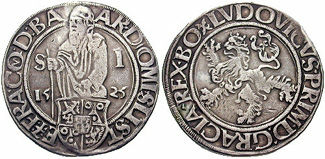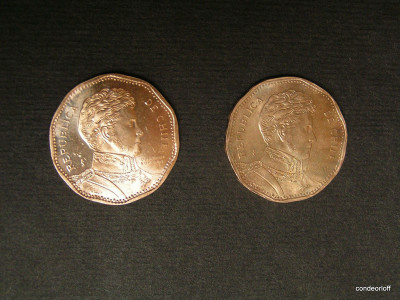Why is the dollar written as '$'? This is the origin of the names of world currencies including 'yen'

The currency used in the United States is the ' dollar ', but the dollar is represented by the symbol ' $ ' and contains an uppercase 'S'. There is no 'S' anywhere in the letter 'dollar'. Why is the dollar written as '$'?
Why Is The Dollar Sign A Letter S?

In the first place, '$' is not a symbol for the dollar, but a symbol for the currency ' peso ' used or used in Spain and the former Spanish colonies.

By
The story goes back to the 1500s, when Bohemia was in the center of Europe, where the Czech Republic is now. Central Europe at that time was a land rich in silver, so for centuries it exported silver abroad to obtain luxury goods such as silk and spices. Silver ore was collected in areas such as Sachsen, Tyrol, and Bohemia in Germany.
In Tyrol, when there is a shortage of gold, silver coins are cast and small gold coins are exchanged for large silver coins as equivalent. This newly cast silver coin, called the 'Guldengroschen coin', is a 32 gram 'almost sterling silver' silver coin that quickly became widely used in the region.
Then, in 1519, Joachimsthal in Bohemia will also be casting its own silver coins. The newly coined silver coin in Bohemia was an improved version of the Guldengroschen coin, with the weight of the currency and the purity of the silver fine-tuned to be divisible by the weights and measures of the currencies in circulation in Europe at the time. When it started to be distributed, it was used all over Europe at once, and it seems that local versions of this Bohemian silver coin were made in various regions. The silver coin made in Bohemia is a currency called ' Thaler ', and there are many currencies made based on this currency. For example, the Dutch Daalder, the Slovenian toral, and even the American dollar are currencies born of Thaler.

by Classical Numismatic Group, Inc. http://www.cngcoins.com
In Central Europe, where various silver coins were born from abundant silver, the abundant resources began to fade around 1530. The discovery of the new continent in Spain has also replaced 85% of the silver mined worldwide over the next 300 years with new continents such as Bolivia, Peru and Mexico. Due to the trend of these times, it became difficult to cast silver coins with high purity in Bolivia and Germany, and it seems that the content rate was gradually reduced.
However, Spain had a large amount of silver from the New World, so there was no need to reduce the silver content of the currency, and it was possible to stably cast high-purity silver coins for a long period of time. The Spanish currency at that time was known as the 'peso silver coin (Spanish dollar)', and thanks to the stable casting of high-purity silver coins, this peso silver coin was gradually used in international trade. As a result, it will replace Thaler.
Over time, peso silver coins will be used in various regions, from the West Indies to the Far East. How wide this range of use was can be seen by thinking of the names of currencies currently used in countries around the world. For example, in the eight countries of Argentina, Chile, Colombia, Cuba, the Dominican Republic, Mexico, the Philippines, and Uruguay, their currencies are still called 'pesos'. This is due to the fact that it was once a Spanish colony and that peso silver coins were used in trade. Furthermore, the currencies such as 'yuan' and 'yen' in China and Japan have been named from the round shape of peso silver coins to the currency name of their own country, such as 'yuan' and 'yen' which means 'round shape'. matter. In addition, it seems that 32% of the world's population uses all the currencies from which the name is derived from peso silver coins.

By Alex Proimos
After the Spanish peso silver coins are distributed all over the world, a new currency will be created in the United States. This is the dollar, and the name was taken from the Spanish peso silver coin (commonly known as the Spanish dollar) and named 'dollar'.
At that time, the pesos distributed all over the world were written as 'peso', so they were not very suitable for handwriting, and it was a character string that took a long time to write. Since the peso silver coin was a widely used currency in international trade, everyone involved in the trade used the peso, and everyone had to write 'peso' in their ledger. Just as the '&' was born from the Latin letter 'et' (meaning and in English), the merchants who continue to write 'peso' every day devised a simple and straightforward abbreviation. First, the 'P' in 'peso' is pluralized and expressed as 'Ps', and 'P' and 'S' are overlapped for easier writing. This symbol became popular, and by the 1770s it had evolved into the current peso symbol '$', which had been stripped of unnecessary parts.

As mentioned above, the US dollar is named after the Spanish peso silver coin, so the '$' is now used in both the peso and the dollar.
Related Posts:
in Note, Posted by logu_ii







